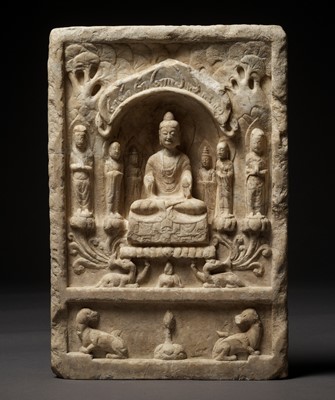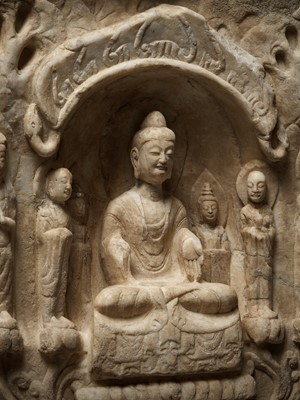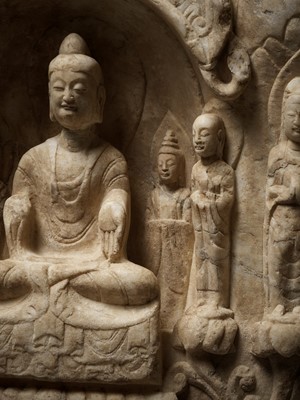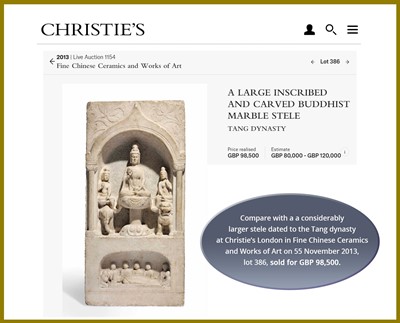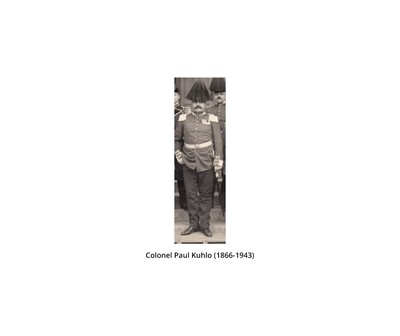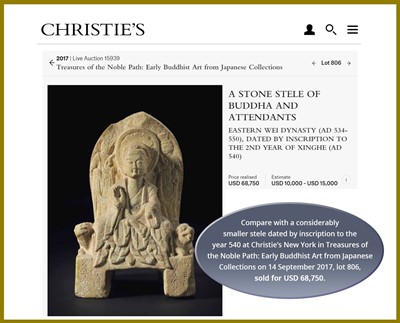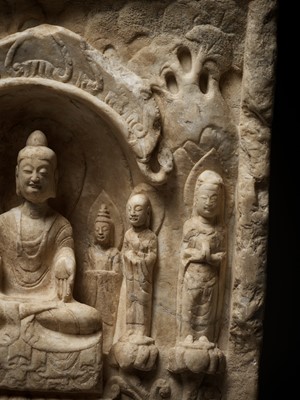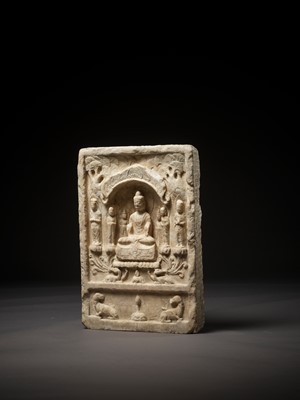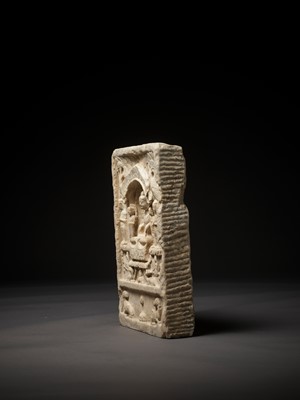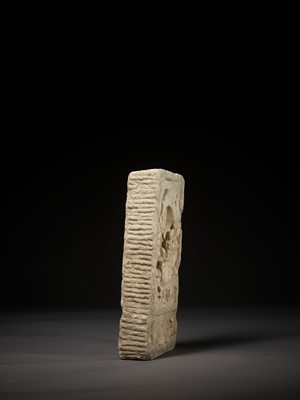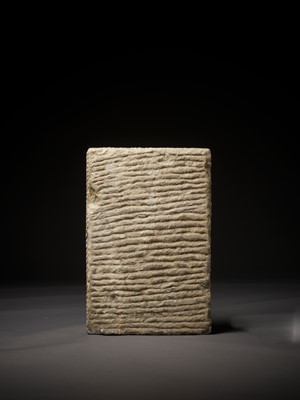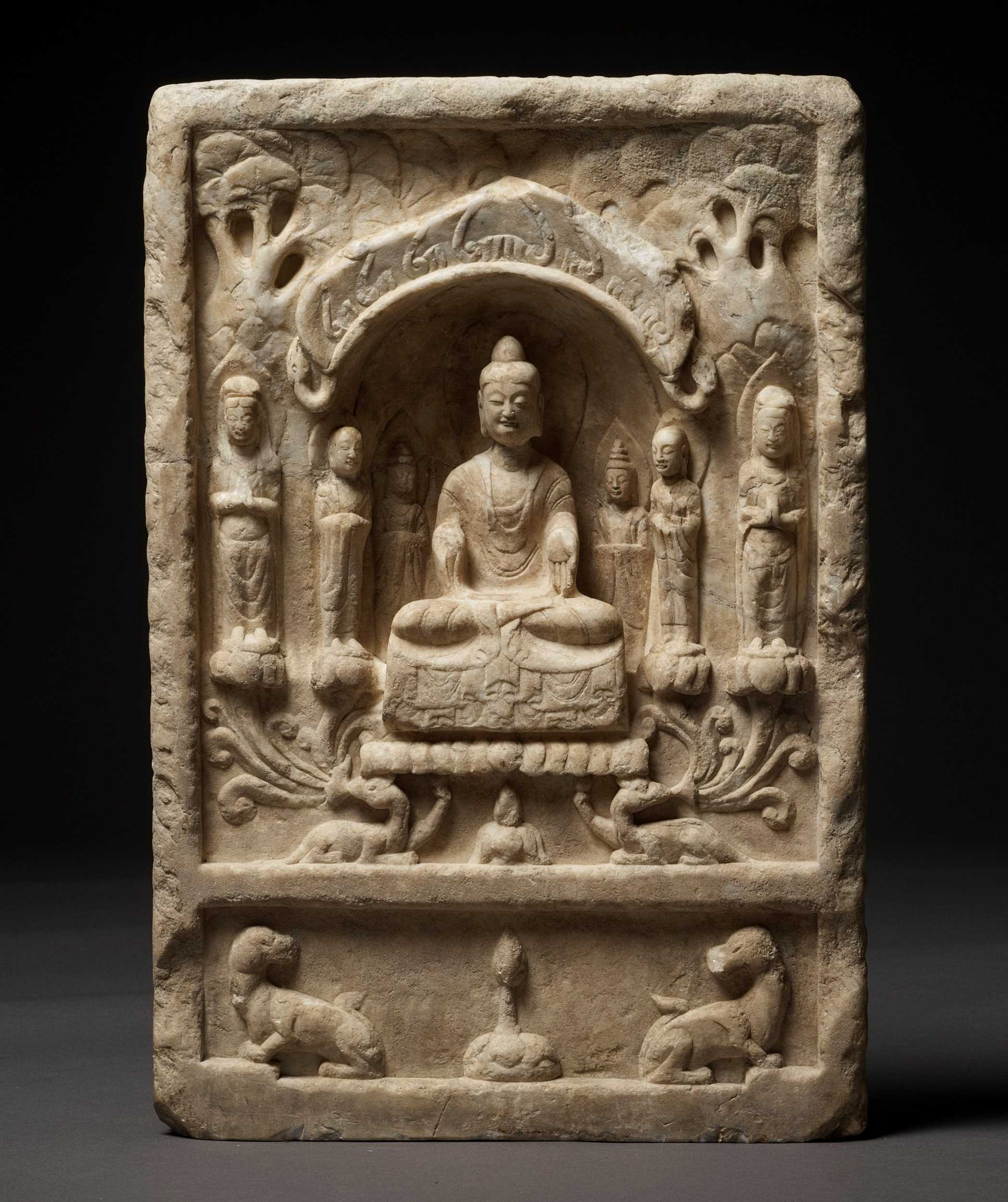6th Mar, 2021 10:00
TWO-DAY AUCTION - Fine Chinese Art / 中國藝術集珍 / Buddhism & Hinduism
491
AN IMPORTANT WHITE MARBLE STELE OF BUDDHA, MAUDGALYAYANA AND SARIPUTRA, NORTHERN QI
北齊重要大理石雕釋迦佛目犍連與舍利弗
Sold for €75,840
including Buyer's Premium
China, 550-577. Carved from a single piece of marble, the central figure of Buddha is seated in dhyanasana on a throne supported on two chilong, his left hand held in abhayamudra, the face in a serene, meditative expression with downcast eyes and a benign smile.
Provenance: Collection of Colonel Paul Kuhlo (1866-1943) and thence by descent in the same family. A noted German private collection, acquired from the above. Colonel Paul Kuhlo was the Commander of the Imperial German East Asian Marine Detachment and a Japanese prisoner of war from 1914 to 1919. During the sunset of his life, he collected Chinese and Japanese stamps, Asian antiques, and transcribed parts of his hand-written diary.
Condition: Good condition commensurate with age, extensive wear, weathering, age cracks, losses, one horizontal crack with old filling.
Dimensions: Height 62 cm, Width 42 cm, Depth 11 cm
With a modern display stand. (2)
Buddha is flanked by two Avalokiteshvara, followed by his two main disciples, Maudgalyayana and Sariputra, and two Guanyin, the latter four standing on lotus pedestals borne on vines issuing from the chilongs’ mouths. The upper section is carved with two bodhi trees, while the lower section shows a boshan lu (hill censer) flanked by two Buddhist lions.
The Northern Qi dynasty (550-577) was one of the most vibrant periods in the history of Chinese art, both religious and secular, as its openness towards foreigners, their ideas, beliefs, and goods immensely enriched the local cultural climate. It was within this cosmopolitan climate that Buddhist sculpture experienced perhaps its most glorious moment. While in the Northern Wei dynasty (386-534), manners of depiction were adapted from traditional South and Central Asian prototypes, in the Northern Qi they had matured and developed into distinctive native styles. However, they still emanate the seriousness of strong religious beliefs, which were rooted in the political instability of the mid-sixth century and had not yet moved towards the pleasant and more decorative imagery of the Tang dynasty (618-907).
The present stele is carved in the simplified style of carving in white marble found in Quyang, Hebei province, and is particularly notable for the sensitively carved face of the main figure. The disciples and bodhisattvas are carved in shallower relief and with even more restraint in detailing, creating a sense of harmony and veneration.
The Palace Museum, Beijing, holds 251 pieces of similarly carved sculpture from Xiude Temple in Quyang which was excavated in 1953-54. Of these Xiude Temple figures, more than 100 are inscribed with Northern Qi reign names, but not all of them.
Auction result comparison: Compare with a considerably smaller stele dated by inscription to the year 540 at Christie’s New York in Treasures of the Noble Path: Early Buddhist Art from Japanese Collections on 14 September 2017, lot 806, sold for USD 68,750, and a considerably larger stele dated to the Tang dynasty at Christie’s London in Fine Chinese Ceramics and Works of Art on 55 November 2013, lot 386, sold for GBP 98,500.
北齊重要大理石雕釋迦佛目犍連與舍利弗
中國, 550-577年。釋迦佛由一塊大理石雕刻而成,他成迦趺座坐在寶座上,手施無畏印,臉部表情沉靜,雙目低垂,微笑著。
來源: Paul Kuhlo上校(1866-1943)藏品,在同一個家庭世代相傳。 一個著名的德國私人收藏,從上述收藏獲得。 Paul Kuhlo上校是德意志帝國東亞海軍陸戰隊司令官,1914至1919年成爲日本戰俘。他在日本時,收集了中國和日本郵票,亞洲古董,並抄寫了部分手寫日記。
圖片:保羅·庫洛上校(1866-1943)
品相:自然老化的狀況與年齡相稱,廣泛的磨損,自然裂縫,風化,一條橫向裂縫,有舊時填充物修補。
尺寸:高 62 厘米, 寬42 厘米, 深 11 厘米
現代底座。
釋迦佛四周可見兩位觀音和目犍連與舍利弗。蓮座上纏枝環繞,上半部分雕刻有兩棵菩提樹,下半部分顯示了兩頭佛教獅子以及兩側的博山爐。
北齊(550-577)是中國藝術史上最活躍的時期之一,無論是宗教的還是世俗的,因為它對外國人的思想、信仰和商品的開放極大地豐富了當地的文化氣候。 正是在這種國際化的氣候中,佛教雕塑經歷了最輝煌的時刻。 在北魏時期(386-534),其描繪方式是根據傳統的南亞和中亞原型改編而成的,而在北齊時期,它們已經成熟並發展成為獨特的本土風格。 然而,他們仍然散發出強烈的宗教信仰的嚴肅性,這些宗教信仰植根於六世紀中葉的政治動盪,尚未走向唐朝(618-907)令人愉悅和更具裝飾性的形象。
這座佛碑與在河北省曲陽市發現的漢白玉佛像雕刻風格極爲相似,尤其是面孔雕刻細節部分。 門徒和菩薩刻有淺淺的浮雕,在細節上有更多的體現,營造出一種和諧和崇高的感覺。
北京故宮博物院保存著251件來自曲陽修德寺的雕塑,這些雕塑是在1953-54年間發掘的。 在這些修德寺人物中,有100多個都刻有北齊王朝的名字,但並非全部。
拍賣結果比較: 一件尺寸較小,年代刻540年的石雕,售于紐約佳士得Treasures of the Noble Path: Early Buddhist Art from Japanese Collections 拍場,2017年9月 14 日, lot 806, 售價USD 68,750, ;一件尺寸較大唐代石碑售于倫敦佳士得 Fine Chinese Ceramics and Works of Art 拍場,2013年11月5日,lot 386, 售價GBP 98,500.
China, 550-577. Carved from a single piece of marble, the central figure of Buddha is seated in dhyanasana on a throne supported on two chilong, his left hand held in abhayamudra, the face in a serene, meditative expression with downcast eyes and a benign smile.
Provenance: Collection of Colonel Paul Kuhlo (1866-1943) and thence by descent in the same family. A noted German private collection, acquired from the above. Colonel Paul Kuhlo was the Commander of the Imperial German East Asian Marine Detachment and a Japanese prisoner of war from 1914 to 1919. During the sunset of his life, he collected Chinese and Japanese stamps, Asian antiques, and transcribed parts of his hand-written diary.
Condition: Good condition commensurate with age, extensive wear, weathering, age cracks, losses, one horizontal crack with old filling.
Dimensions: Height 62 cm, Width 42 cm, Depth 11 cm
With a modern display stand. (2)
Buddha is flanked by two Avalokiteshvara, followed by his two main disciples, Maudgalyayana and Sariputra, and two Guanyin, the latter four standing on lotus pedestals borne on vines issuing from the chilongs’ mouths. The upper section is carved with two bodhi trees, while the lower section shows a boshan lu (hill censer) flanked by two Buddhist lions.
The Northern Qi dynasty (550-577) was one of the most vibrant periods in the history of Chinese art, both religious and secular, as its openness towards foreigners, their ideas, beliefs, and goods immensely enriched the local cultural climate. It was within this cosmopolitan climate that Buddhist sculpture experienced perhaps its most glorious moment. While in the Northern Wei dynasty (386-534), manners of depiction were adapted from traditional South and Central Asian prototypes, in the Northern Qi they had matured and developed into distinctive native styles. However, they still emanate the seriousness of strong religious beliefs, which were rooted in the political instability of the mid-sixth century and had not yet moved towards the pleasant and more decorative imagery of the Tang dynasty (618-907).
The present stele is carved in the simplified style of carving in white marble found in Quyang, Hebei province, and is particularly notable for the sensitively carved face of the main figure. The disciples and bodhisattvas are carved in shallower relief and with even more restraint in detailing, creating a sense of harmony and veneration.
The Palace Museum, Beijing, holds 251 pieces of similarly carved sculpture from Xiude Temple in Quyang which was excavated in 1953-54. Of these Xiude Temple figures, more than 100 are inscribed with Northern Qi reign names, but not all of them.
Auction result comparison: Compare with a considerably smaller stele dated by inscription to the year 540 at Christie’s New York in Treasures of the Noble Path: Early Buddhist Art from Japanese Collections on 14 September 2017, lot 806, sold for USD 68,750, and a considerably larger stele dated to the Tang dynasty at Christie’s London in Fine Chinese Ceramics and Works of Art on 55 November 2013, lot 386, sold for GBP 98,500.
北齊重要大理石雕釋迦佛目犍連與舍利弗
中國, 550-577年。釋迦佛由一塊大理石雕刻而成,他成迦趺座坐在寶座上,手施無畏印,臉部表情沉靜,雙目低垂,微笑著。
來源: Paul Kuhlo上校(1866-1943)藏品,在同一個家庭世代相傳。 一個著名的德國私人收藏,從上述收藏獲得。 Paul Kuhlo上校是德意志帝國東亞海軍陸戰隊司令官,1914至1919年成爲日本戰俘。他在日本時,收集了中國和日本郵票,亞洲古董,並抄寫了部分手寫日記。
圖片:保羅·庫洛上校(1866-1943)
品相:自然老化的狀況與年齡相稱,廣泛的磨損,自然裂縫,風化,一條橫向裂縫,有舊時填充物修補。
尺寸:高 62 厘米, 寬42 厘米, 深 11 厘米
現代底座。
釋迦佛四周可見兩位觀音和目犍連與舍利弗。蓮座上纏枝環繞,上半部分雕刻有兩棵菩提樹,下半部分顯示了兩頭佛教獅子以及兩側的博山爐。
北齊(550-577)是中國藝術史上最活躍的時期之一,無論是宗教的還是世俗的,因為它對外國人的思想、信仰和商品的開放極大地豐富了當地的文化氣候。 正是在這種國際化的氣候中,佛教雕塑經歷了最輝煌的時刻。 在北魏時期(386-534),其描繪方式是根據傳統的南亞和中亞原型改編而成的,而在北齊時期,它們已經成熟並發展成為獨特的本土風格。 然而,他們仍然散發出強烈的宗教信仰的嚴肅性,這些宗教信仰植根於六世紀中葉的政治動盪,尚未走向唐朝(618-907)令人愉悅和更具裝飾性的形象。
這座佛碑與在河北省曲陽市發現的漢白玉佛像雕刻風格極爲相似,尤其是面孔雕刻細節部分。 門徒和菩薩刻有淺淺的浮雕,在細節上有更多的體現,營造出一種和諧和崇高的感覺。
北京故宮博物院保存著251件來自曲陽修德寺的雕塑,這些雕塑是在1953-54年間發掘的。 在這些修德寺人物中,有100多個都刻有北齊王朝的名字,但並非全部。
拍賣結果比較: 一件尺寸較小,年代刻540年的石雕,售于紐約佳士得Treasures of the Noble Path: Early Buddhist Art from Japanese Collections 拍場,2017年9月 14 日, lot 806, 售價USD 68,750, ;一件尺寸較大唐代石碑售于倫敦佳士得 Fine Chinese Ceramics and Works of Art 拍場,2013年11月5日,lot 386, 售價GBP 98,500.
Zacke Live Online Bidding
Our online bidding platform makes it easier than ever to bid in our auctions! When you bid through our website, you can take advantage of our premium buyer's terms without incurring any additional online bidding surcharges.
To bid live online, you'll need to create an online account. Once your account is created and your identity is verified, you can register to bid in an auction up to 12 hours before the auction begins.
Intended Spend and Bid Limits
When you register to bid in an online auction, you will need to share your intended maximum spending budget for the auction. We will then review your intended spend and set a bid limit for you. Once you have pre-registered for a live online auction, you can see your intended spend and bid limit by going to 'Account Settings' and clicking on 'Live Bidding Registrations'.
Your bid limit will be the maximum amount you can bid during the auction. Your bid limit is for the hammer price and is not affected by the buyer’s premium and VAT. For example, if you have a bid limit of €1,000 and place two winning bids for €300 and €200, then you will only be able to bid €500 for the rest of the auction. If you try to place a bid that is higher than €500, you will not be able to do so.
Online Absentee and Telephone Bids
You can now leave absentee and telephone bids on our website!
Absentee Bidding
Once you've created an account and your identity is verified, you can leave your absentee bid directly on the lot page. We will contact you when your bids have been confirmed.
Telephone Bidding
Once you've created an account and your identity is verified, you can leave telephone bids online. We will contact you when your bids have been confirmed.
Classic Absentee and Telephone Bidding Form
You can still submit absentee and telephone bids by email or fax if you prefer. Simply fill out the Absentee Bidding/Telephone bidding form and return it to us by email at office@zacke.at or by fax at +43 (1) 532 04 52 20. You can download the PDF from our Upcoming Auctions page.
How-To Guides
How to Create Your Personal Zacke Account
How to Register to Bid on Zacke Live
How to Leave Absentee Bids Online
How to Leave Telephone Bids Online
中文版本的操作指南
创建新账号
注册Zacke Live在线直播竞拍(免平台费)
缺席投标和电话投标
Third-Party Bidding
We partner with best-in-class third-party partners to make it easy for you to bid online in the channel of your choice. Please note that if you bid with one of our third-party online partners, then there will be a live bidding surcharge on top of your final purchase price. You can find all of our fees here. Here's a full list of our third-party partners:
- 51 Bid Live
- EpaiLive
- ArtFoxLive
- Invaluable
- LiveAuctioneers
- the-saleroom
- lot-tissimo
- Drouot
Please note that we place different auctions on different platforms. For example, in general, we only place Chinese art auctions on 51 Bid Live.
Bidding in Person
You must register to bid in person and will be assigned a paddle at the auction. Please contact us at office@zacke.at or +43 (1) 532 04 52 for the latest local health and safety guidelines.
